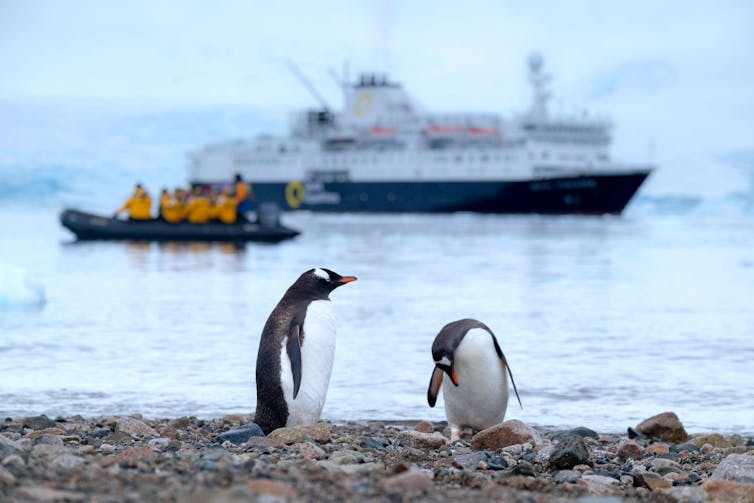In October 2017, Antarctic science had its own #MeToo moment. Science magazine published a piece on allegations of abuse of female geoscientists in Antarctica – the most remote environment in the world.
US geologist Jane Willenbring detailed appalling sexual harassment during periods of Antarctic fieldwork in the 1990s by her Boston University PhD supervisor David Marchant. After a lengthy investigation, Marchant was fired, and a glacier was renamed to wipe his name off the map.
Willenbring’s testimony was shocking to many in the broader public. But anecdotally, sexual harassment has been an integral part of working in Antarctica for women.
72% of women report harassment
This was confirmed in a recently released report commissioned by the National Science Foundation, which reveals that US Antarctic stations are “plagued” by sexual harassment.
Seventy-two per cent of women surveyed in the report said sexual harassment was a problem in the US Antarctic Program (USAP). Alarmingly, there was low consensus among senior USAP leadership that harassment is a serious problem. Infrastructure to prevent sexual harassment in the program is described as “virtually absent”.
The report includes stomach-churning extracts from interviews with past and current USAP expeditioners:
Every woman I knew down there had an assault or harassment experience that had occurred on ice.
Most people forget that Antarctica is not just a remote, largely empty continent – it’s also a workplace like any other. But the extreme isolation and confinement can create a permissive environment for harassment.
“What happens in Antarctica, stays in Antarctica” encapsulates a view that Antarctica is removed from home not just geographically, but in terms of ethical standards.

Why is sexual harassment rife in Antarctica?
Sexual harassment is an umbrella term. It refers to behaviour that demeans or humiliates an individual based on their sex.
It is prevalent in Antarctica due to historical, cultural and relational factors.
Historically, Antarctica has been a site for masculine feats of endurance, and women were long denied access to the continent – until the early 1980s – in the US, United Kingdom and Australia.
Although women are working in Antarctica in greater numbers now, the cultures of Antarctic science and expeditions remain dominated by men and masculinity. Most Antarctic expeditioners are men, and men dominate senior science leadership in Australia and elsewhere.
Read more: Finding Shackleton's ship: why our fascination with Antarctica endures
The hierarchies at play
Making sexual harassment visible and addressing it institutionally is difficult in Antarctica.
One reason is the hierarchical nature of relationships inside Antarctic stations, in scientific research, and in the field.
For instance, PhD students in Antarctic science heavily rely on their supervisors to provide feedback, funding, fieldwork opportunities and mentorship throughout the candidature. The fear of losing this support often motivates them to stay silent about sexual harassment.
For example, Willenbring waited until she had a tenured academic position – nearly 17 years after her last Antarctic expedition with Marchant – to report her harassment claim because she was no longer worried he could ruin her career.
Women who work in Antarctica also rarely report sexual harassment because working in small teams in remote stations or field camps can make it difficult to report incidents or to leave the situation. Reporting is often not seen as viable solution when the human resources office is more than 4,000km away.
Women also often hesitate to complain because they worry it will end their Antarctic career.
Read more: People stationed in Antarctica menstruate too – and it's a struggle. Here's how we can support them
It’s time for a change
Five years since the ##MeToo movement began, little has changed in Antarctica.
National Antarctic programs have done relatively little to explicitly address harassment as a primary safety issue on station and in the field.
And sexual harassment is not confined to the USAP. In 2018, I surveyed women in the Australian Antarctic Program about their experiences of harassment.
My findings are disturbingly similar to the results of the USAP report. Sixty-three per cent of women who responded to my survey reported having experienced inappropriate or sexual remarks when in the field.
Organisational leadership is vital for helping bring about cultural change. In Antarctica, this includes National Antarctic programs and international committees such as the Scientific Committee for Antarctic Research and the Council of Managers of National Antarctic Programs.
These bodies play a vital role in communicating the importance of building respectful station and field environments, and fostering a culture of prevention. The onus should not be on victim–survivors to come forward.
What can we do to stop harassment?
We know what needs to be done. Here are key recommendations for positive change:
National Antarctic programs explicitly defining sexual harassment and setting out individual and institutional responsibilities
treating sexual harassment as a serious work health and safety issue. Providing more expansive definitions of “risk” and “danger” in training, policies and relevant field manuals
expeditioners should have information about multiple channels through which to make a complaint and understand how the reporting process works
regularly communicating the policies and appropriately training expeditioners in relation to their content
not relying solely on victim-survivors formally reporting to make abuse visible. We should focus on preventing harassment from happening in the first place.
Respectful, inclusive workplace environments do not happen by accident – they are intentionally created. One consistent factor that emerges across accounts of sexual harassment in Antarctica is that many women feel they were insufficiently prepared for what they would encounter.
Sexual harassment is linked to many significant negative health outcomes. It is unethical to continue to recruit women to work in Antarctica if National Antarctic programs have few mechanisms to keep them safe.
Meredith Nash previously served as Senior Advisor - Inclusion, Diversity, and Equity at the Australian Antarctic Division (2020-22). She previously received funding from the Australian Antarctic Division.
This article was originally published on The Conversation. Read the original article.







